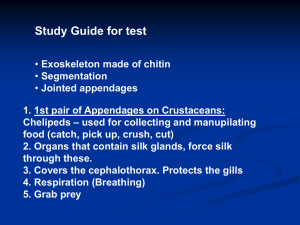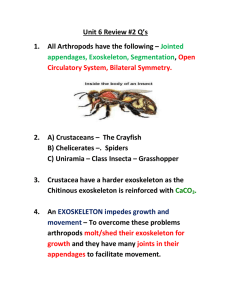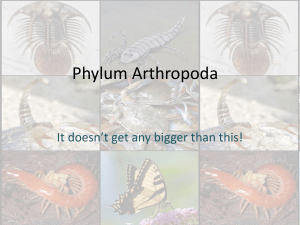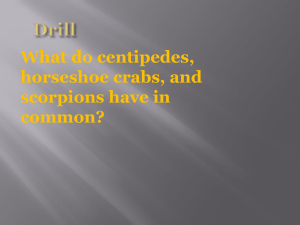Phylum Arthropoda Review PPT
advertisement
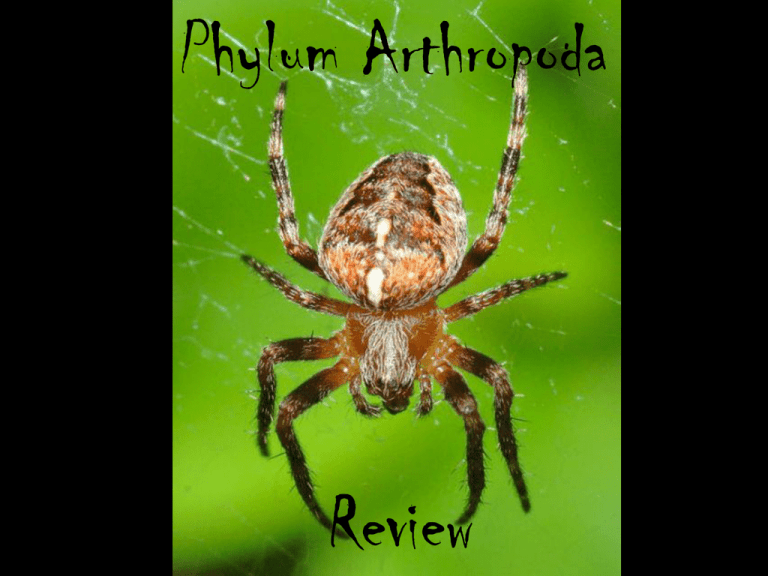
Phylum Arthropoda Review Word Bank Complete metamorphosis herbivores pesticides swimmerets exoskeleton bilateral antennae molting Egg hatches to larva larva enters pupa stage adult emerges from pupa stage Complete metamorphosis Word Bank Complete metamorphosis herbivores pesticides swimmerets exoskeleton bilateral antennae molting Process of shedding an outgrown exoskeleton molting Word Bank Complete metamorphosis herbivores pesticides swimmerets exoskeleton bilateral antennae molting Waxy, waterproof outer covering of arthropods exoskeleton Word Bank Complete metamorphosis herbivores pesticides swimmerets exoskeleton bilateral antennae molting Type of symmetry found in arthropods bilateral Word Bank Complete metamorphosis herbivores pesticides swimmerets exoskeleton bilateral antennae molting Chemicals used to kill harmful insects pesticides Word Bank Complete metamorphosis herbivores pesticides swimmerets exoskeleton bilateral antennae molting Arthropods that feed on plants (e.g. Japanese beetles) herbivores Word Bank Complete metamorphosis herbivores pesticides swimmerets exoskeleton bilateral antennae molting Appendages used by crustaceans like paddles; also to attach and carry eggs swimmerets Word Bank Complete metamorphosis herbivores pesticides swimmerets exoskeleton bilateral antennae molting Segmented appendages used to smell, taste, touch and balance antennae Behind the mystery door is a Black Widow Spider. How many legs does the black widow have? 8 Behind the mystery door is a Black Widow Spider. How many pairs of antennae does it have? 0 Behind the mystery door is a Rusty millipede. Is it a carnivore or scavenger? scavenger Behind the mystery door is a Rusty millipede. What type of circulatory system does it have? Open Behind the mystery door is a Honey Bee How many legs does it have? 6 Behind the mystery door is a Honey Bee Which body section has legs and wings? thorax Behind the mystery door is a Honey Bee How many body sections does it have? 3 Match the organism to its correct class Diplopoda Chilopoda Crustacea Arachnid Insecta Jumping spider Arachnid Match the organism to its correct class Diplopoda Chilopoda Crustacea Arachnid Insecta Thrip Insecta Match the organism to its correct class Diplopoda Chilopoda Crustacea Arachnid Insecta Crayfish Crustacea Match the organism to its correct class Diplopoda Chilopoda Crustacea Arachnid Insecta Goliath Beetle Insecta Match the organism to its correct class Diplopoda Chilopoda Crustacea Arachnid Insecta millipede Diplopoda Match the organism to its correct class Diplopoda Chilopoda Crustacea Arachnid Insecta centipede Chilopoda Match the organism to its correct class Diplopoda Chilopoda Crustacea Arachnid Insecta yellow dog tick Arachnid Word Bank Antennae Cheliped walking legs swimmerets swimmerets antennae cheliped antennae Walking legs Ladybugs, praying mantises, as well as adult and larval lacewings are this type of beneficial insect. A. structural pests B. producer C. pollinator D. biological control Insects that are essential for reproduction in plants area called A. structural pests B. producer C. pollinator D. herbivores Termites in the soil of forests feed on fallen trees. In this way termites are beneficial A. structural pests B. parasites C. pollinators D. decomposers Possibly the most dangerous animal, these insects transmit diseases such as malaria, yellow fever, and West Nile virus. A. flies B. mosquitoes C. fleas D. lice Which of the following arthropods is not correctly labeled? A. Ladybird beetle (ladybug) decomposer B. Aphid – insect pest C. Grasshopper – food source/ nutrition D. Bumblebee pollinator Describe gradual metamorphosis in insects. List all the stages and provide an insect that undergoes this process. What is biological control of insects? Give an example. What is an advantage of the use of biological controls over the use of pesticides? Biological control of insects is the use of natural predators released into an area to fight a harmful pest or insect.
